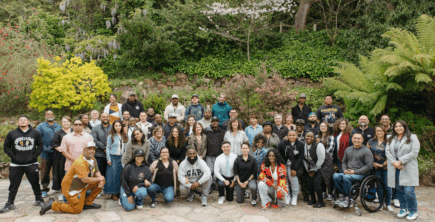
LGBT

As Black Philanthropy Month comes to an end, I am reminded of key themes from an event I attended earlier this month, “This Is What A Philanthropist Looks Like,” offered by the San Francisco-based organization How Women Lead.

© Christina Wocintechchat
The event sought to define philanthropy in a broader context, beyond those who are seen as members of an exclusive white, wealthy club. The host kicked off the event by asking attendees whether we viewed ourselves as philanthropists. The term “philanthropist” typically conjures up images of older, wealthy white males, and with this, we envision centralized models of philanthropy where wealth is controlled by a select few. However, despite this persona, many of the event’s attendees of color still considered themselves philanthropists.
In order to help build a more inclusive understanding of philanthropy—which is always one of Tides’ primary goals—I have identified three core tenets that the sector should adopt. By embracing these, philanthropists can consciously dismantle myths about how the Black community practices, and engages with, different forms of giving:
The first tenet requires an understanding of the evolution of giving in the Black community that has its roots in Africa. Indigenous forms of giving across the continent were not documented extensively in formal settings. Instead, the focus on philanthropy places Africans as the recipients of aid. By extension, the Black community has long been excluded from spaces that acknowledge their role as philanthropists. This idea has become a myth that pervades certain spaces despite the fact that African American families have—more than any other racial group—contributed the largest portion of their wealth to charity.
The second tenet is fixated on the language we use to define philanthropy. The term, “philanthropy” is an uncommon characterization of the altruistic nature of African societies. At its core, the practice of philanthropy is rooted in an unspoken contract committed to the collective benefit of the community. During the event I attended, a fellow participant mentioned that the idea of announcing oneself as a philanthropist belies the selfless nature of philanthropy.
Until Black philanthropists develop our own taxonomy, we’re forced to use that of others, which carries its own history. Harris Bostic II, Senior Strategic Advisor at Tides, calls for demystifying philanthropy and embracing other inclusive definitions that provide a roadmap for wealth accumulation and distribution. This makes the idea of becoming a philanthropist, or owner of wealth, that much more accessible.
Why is it important for institutional philanthropy to make room for this nuanced understanding of Black philanthropy? By acknowledging the history of giving in the Black community, institutional philanthropy can more readily embrace trust-based philanthropy and entrust the Black community to be responsible and resourceful stewards of funds. A New York Times article highlighted how nonprofit groups led by Black and Latinx directors lag behind in receiving funding dollars when compared to nonprofit groups led by white leaders.
Peter Martin, Philanthropic Director at Tides, has been on both sides of philanthropy as the beneficiary and funder. In order to level the playing field, Peter emphasizes the importance of using a lens that understands this history and places equity at the forefront of developing solutions.

As someone who has worked in the philanthropic space for a decade, I have witnessed firsthand how outdated models of philanthropy miss the critical value of a two-way dialogue between donors and recipients. By challenging traditional philanthropy to practice grantmaking using a historical lens, funders will be forced to welcome the backgrounds and opinions of those who are often left out. This brings the sector much closer to demystifying the elusive space that philanthropy has become.
There are groups that are already committed to this work, including the national organization Emerging Practitioners in Philanthropy (EPIP)—a partner of the Tides Center—who is helping foundation staff bring inclusive changes into their institutions and improve grantmaking practices for the overall field. The Association of Black Foundation Executives (ABFE) is another philanthropic organization with a long history in this space that advocates for responsive and transformative investments in Black communities.
By challenging traditional philanthropy to practice grantmaking using a historical lens, funders will be forced to welcome the backgrounds and opinions of those who are often left out. This brings the sector much closer to demystifying the elusive space that philanthropy has become.
In terms of the tools used by the sector to guide grantmaking, The Philanthropic Initiative for Racial Equity (PRE), another partner of Tides, created a resource guide, “Grantmaking with a Racial Justice Lens: A Practical Guide” to support structural transformation in philanthropy.
I believe that the tools, resources and tenets above are foundational as the sector works to create a more inclusive, responsive, and equitable form of philanthropy.
As to the question of whether I personally identify as a philanthropist, I’m not entirely sure, but the history of Black philanthropy is a reminder that I should never doubt my agency in how I choose to practice giving and build wealth.

LGBT

Corporate Partners

Philanthropy

Read the stories and hear the voices of social change leaders fighting for justice.